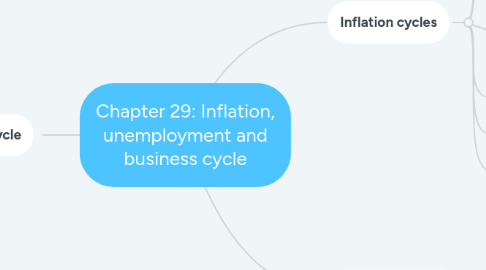
1. Inflation cycles
1.1. Demand-Pull Inflation
1.1.1. Due to aggregate demand increases
1.2. Money Wage Rate Response
1.2.1. Potential GDP>Real GDP
1.3. A Demand-Pull inflation Process
1.3.1. "one-time in the price level"
1.4. Cost-Push Inflation
1.4.1. Inflation that is kicked off by an increase in cost
1.4.1.1. Initial Effect of Decrease in AS
1.4.1.1.1. "One-time rise in the price level"
1.4.1.2. Aggregate Demand Response
1.4.1.2.1. GDP decreases UNEMPLOYMENT rise
1.4.1.3. A Cost-Push Inflation Process
1.4.1.3.1. Stagflation
1.5. Inflation and BC
1.5.1. Forecast correct=Full employment
1.6. Forecasting Inflation
1.6.1. Rational expectation
1.6.1.1. Best forecast based on all relevant information
1.7. Expected Inflation
1.7.1. Inflation proceedds as it does in the LR
1.7.1.1. Real GDP=Potential GDP
2. The Philips Curve
2.1. Inflation focuses on the relationship and the SR
2.1.1. Simpler tool and clearer insights than AS-AD model
2.2. The SR PC
2.2.1. Shows the relationship between inflation and unemployment
2.2.1.1. Expected inflation rate
2.2.1.2. The natural unemployment rate
2.3. The LR PC
2.3.1. Shows the relationship between inflation and unemployment when the actual inflation rate equals the expected inflation rate
2.4. Changes in the Natural Unemployment Rate
2.4.1. Shift both SR and LR Philips curves
3. The Business Cycle
3.1. Meaning
3.1.1. Mainstream business cycle theory
3.1.2. Real business cycle theory
3.2. Mainstream BC theory
3.2.1. Potential GDP grows at steady rate
3.2.2. Aggregate demand grows at a fluctuating rate
3.3. Real BC theory
3.3.1. Productivity fluctuations are assumed to result mainly from fluctuations in the pace of technological change
